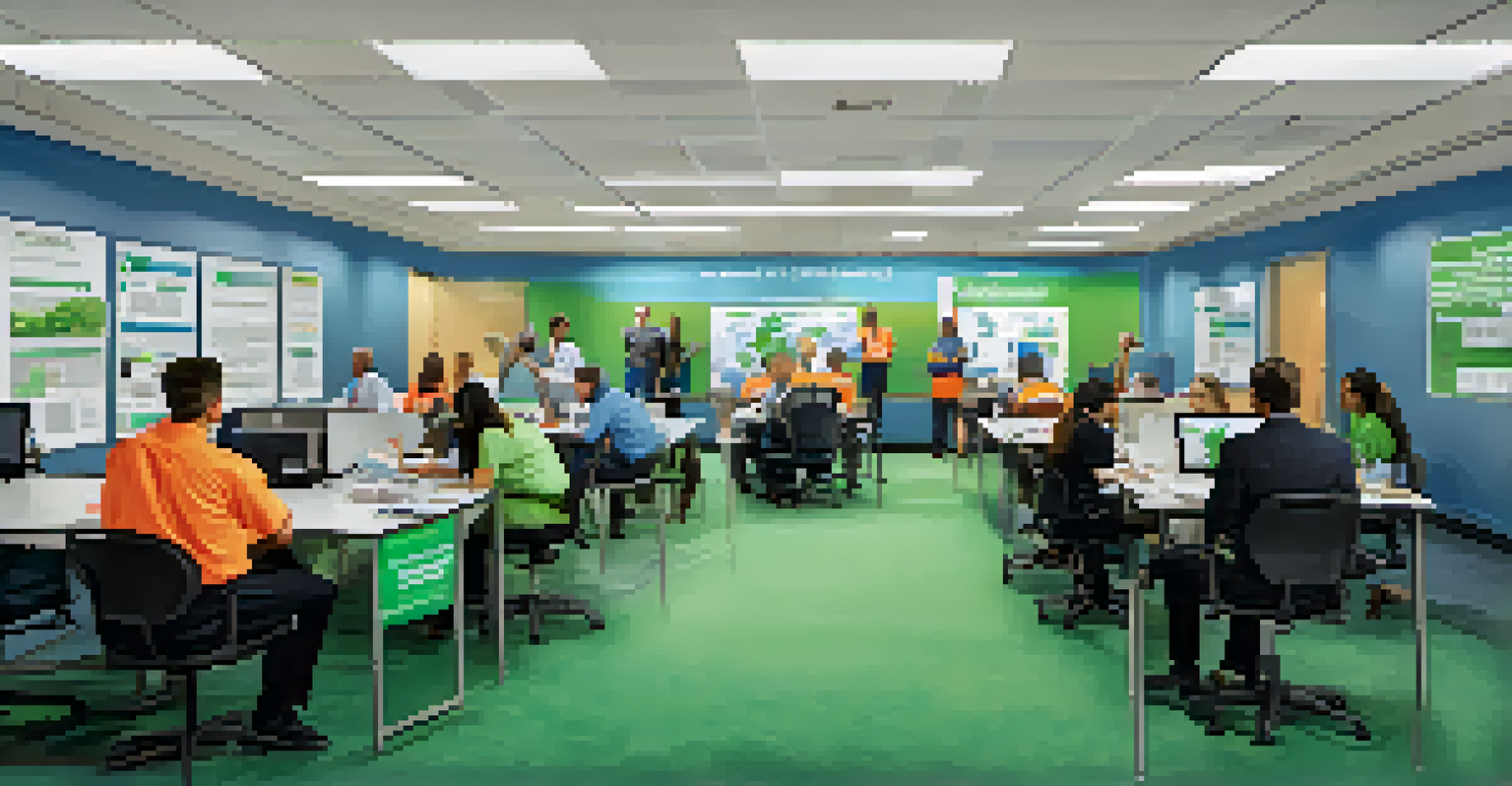Common Workplace Hazards and How to Mitigate Them

Understanding Workplace Hazards: What Are They?
Workplace hazards are conditions or practices that could potentially cause harm to employees. These can range from physical issues, like slippery floors, to ergonomic concerns, such as improper workstation setups. Understanding these hazards is the first step in creating a safe work environment.
Safety isn't just a slogan, it's a way of life.
It's essential to recognize that hazards can be classified into various categories: physical, chemical, biological, ergonomic, and psychosocial. Each category presents unique risks and requires specific strategies to manage them effectively. By identifying these hazards, companies can prioritize their efforts in safety management.
For instance, a manufacturing plant may face different hazards compared to a corporate office. By conducting regular assessments, employers can pinpoint which hazards are most relevant to their specific settings, allowing for tailored safety measures that protect all employees.
Physical Hazards: Slips, Trips, and Falls
One of the most common physical hazards in the workplace is slips, trips, and falls. These incidents can occur due to wet floors, cluttered walkways, or uneven surfaces. Not only can they lead to serious injuries, but they can also result in increased absenteeism and healthcare costs for employers.

To mitigate this risk, organizations should implement regular cleaning schedules and ensure that all walkways are clear of obstacles. Installing non-slip flooring in high-risk areas and using proper signage to indicate wet floors can also be effective strategies. Training employees to be aware of their surroundings can further enhance safety.
Identify Workplace Hazards
Recognizing various workplace hazards is essential for creating a safe environment and implementing tailored safety measures.
It's also beneficial to encourage a culture of reporting hazards. When employees feel empowered to point out unsafe conditions, it helps create a proactive approach to workplace safety, ultimately reducing incidents and fostering a safer environment.
Ergonomic Hazards: Preventing Strain and Injury
Ergonomic hazards arise when the workplace design does not fit the needs of the employees, leading to discomfort and injury. Common issues include poor workstation setups, repetitive motions, and awkward postures. These factors can contribute to musculoskeletal disorders, which can be debilitating over time.
An ounce of prevention is worth a pound of cure.
To combat these hazards, employers should invest in ergonomic assessments of workspaces. This may involve providing adjustable chairs, standing desks, and tools that minimize strain, like ergonomic keyboards. Encouraging regular breaks and stretching exercises can also help alleviate the physical stress associated with repetitive tasks.
By prioritizing ergonomics, companies not only protect their employees' health but also boost productivity. When workers are comfortable and pain-free, they are more likely to be engaged and efficient in their roles.
Chemical Hazards: Handling Toxic Substances Safely
Chemical hazards refer to the risks associated with exposure to harmful substances in the workplace. This can include anything from cleaning products to industrial chemicals. Prolonged exposure to these substances can lead to serious health issues, including respiratory problems and skin disorders.
To mitigate chemical hazards, it's crucial for companies to implement proper storage and labeling of hazardous materials. Providing employees with access to Material Safety Data Sheets (MSDS) can educate them on the risks and safe handling procedures. Regular training sessions on chemical safety should also be a priority.
Promote Employee Safety Culture
Fostering a culture of safety encourages open communication and proactive behavior, reducing risks and enhancing well-being.
In addition, investing in appropriate Personal Protective Equipment (PPE), such as gloves and masks, can further protect workers from exposure. By fostering a culture of safety around chemical handling, employers can significantly reduce the risk of related injuries and illnesses.
Biological Hazards: Protecting Against Infectious Agents
Biological hazards involve exposure to harmful biological substances, such as bacteria, viruses, and fungi. In workplaces like healthcare facilities, these hazards are particularly prevalent and can pose serious health risks to employees. Understanding how to handle biological materials is essential for maintaining a safe environment.
To mitigate biological hazards, organizations should implement strict hygiene protocols, including regular handwashing and the use of sanitizers. Providing employees with training on infection control and the proper use of PPE, such as gloves and masks, is also crucial.
Moreover, maintaining clean facilities and ensuring proper waste disposal can significantly reduce the risk of biological hazards. By prioritizing health and safety measures, employers not only protect their workforce but also enhance overall workplace morale.
Psychosocial Hazards: Addressing Mental Health Risks
Psychosocial hazards relate to the mental and emotional well-being of employees. Factors such as workplace bullying, excessive workload, and lack of support can lead to stress and burnout. Addressing these issues is vital for fostering a healthy work environment and retaining talent.
Employers can mitigate psychosocial hazards by promoting open communication and providing resources for mental health support. Initiatives such as employee assistance programs (EAPs) and stress management workshops can empower employees to seek help when needed.
Emergency Preparedness Matters
Having a comprehensive emergency preparedness plan is crucial for ensuring employee safety during unexpected situations.
Creating a supportive workplace culture that values work-life balance can also make a significant difference. By prioritizing mental health and well-being, organizations not only enhance employee satisfaction but also improve overall productivity.
Emergency Preparedness: Planning for the Unexpected
Emergency preparedness is crucial in any workplace to ensure the safety of employees during unexpected situations. Whether it's a fire, natural disaster, or medical emergency, having a plan in place can save lives and minimize damage. Understanding potential risks specific to the workplace is the first step in effective planning.
Employers should conduct regular emergency drills and provide training on evacuation procedures, first aid, and how to respond in various scenarios. Posting clear evacuation routes and emergency contact information throughout the workplace can also enhance preparedness.

By fostering a culture of readiness, employees will feel more confident and secure. This not only contributes to their safety but also promotes a sense of community and cooperation in facing challenges together.
Creating a Culture of Safety: Everyone's Responsibility
Building a culture of safety in the workplace is a collective responsibility that involves everyone—from management to employees. When safety becomes a shared value, it encourages open communication and proactive behavior regarding hazards. This collaborative approach can significantly reduce risks and enhance overall well-being.
Employers should encourage employees to participate in safety committees and provide feedback on potential hazards. Recognizing and rewarding safe practices can also motivate individuals to prioritize safety in their daily routines. Regular training and refresher courses can keep safety top-of-mind for everyone.
Ultimately, a safety-oriented culture leads to a more engaged and productive workforce. When employees feel valued and protected, they are more likely to contribute positively to the organization's success.